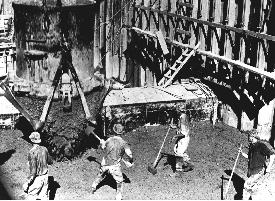Hoover Dam
Fatalities at Hoover Dam
 Many people come to Hoover Dam and take our tour. Probably
the two most asked questions are: 1) How many people died building the dam? and
2) How many of those are buried in the concrete? The second question is the
easiest to answer -- none! There are no bodies buried in the concrete.
Many people come to Hoover Dam and take our tour. Probably
the two most asked questions are: 1) How many people died building the dam? and
2) How many of those are buried in the concrete? The second question is the
easiest to answer -- none! There are no bodies buried in the concrete.
The dam was built in interlocking blocks, built on top of each other as they went. Each block was five feet high. The smallest blocks were about 25 by 25 feet, and the largest blocks were about 25 by 60 feet. Concrete was delivered to the blocks in buckets, eight cubic yards at a time. After each bucket was delivered five or six men would tromp around on the inside of the block, packing down the concrete and making sure there were no air holes. These men were called "Puddlers". Each time a bucket was emptied into the largest blocks the level of the concrete increased by two to three inches. How can you lose a body in two to three inches of concrete? Of course the smaller blocks did fill up faster. Each time a bucket was emptied into the smaller blocks the level was raised about six inches. Even with six inches the nose and the toes would have stuck out, and the puddlers would have seen them. There are no bodies buried in Hoover Dam. In fact we call that a Dam Rumor.
The first question is more difficult to answer. There are various numbers that can be used depending on who you include as having died on the project. One popular number is 112, but it requires some stretching to make it fit. With this number you get the story of the first and last men to die on the project. It goes something like this. On December 20, 1922, J.G. Tierney, a Bureau of Reclamation employee engaged in a geological survey from a barge in the Colorado River fell in the river and drowned. Thirteen years to the day, on December 20, 1935, Patrick W. Tierney, a Bureau or Reclamation employee and son of J.G. Tierney, fell from one of the intake towers. This version has a couple of problems. First, the dam was built from 1931 to 1935, so J.G. Tierney was not really involved in the "construction" of the dam. He was doing a geological survey to decide where the dam would be built, but he was not the first person doing the survey to die. On May 15, 1922, Harold Connelly, also fell off of a barge and drowned. So, why isn't he considered the first person to die on the project. Well, for one thing it would not make as good a story as the Tierney family. To get around this people point out that Connelly died while surveying a canyon upstream from the present site of the dam, while both Tierneys died in the canyon where the dam was eventually built.
Another common number is 96. There were 96 industrial fatalities during the construction of the dam. Industrial fatalities includes deaths from drowning, blasting, falling rocks or slides, falls from the canyon walls, struck by heavy equipment, truck accidents, etc. Industrial fatalities do not include deaths from the heat, pneumonia, heart trouble, etc.
Source - U.S. Department of the Interior - Bureau of Reclamation